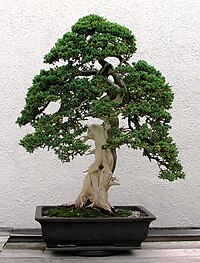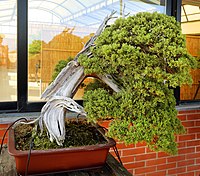Bonsai styles[edit]
The Japanese tradition describes bonsai tree designs using a set of commonly understood, named styles.[69] The most common styles include formal upright, informal upright, slanting, semi-cascade, cascade, raft, literati, and group/forest. Less common forms include windswept, weeping, split-trunk, and driftwood styles.[6][70] These terms are not mutually exclusive, and a single bonsai specimen can exhibit more than one style characteristic. When a bonsai specimen falls into multiple style categories, the common practice is to describe it by the dominant or most striking characteristic.
A frequently used set of styles describes the orientation of the bonsai tree's main trunk. Different terms are used for a tree with its apex directly over the center of the trunk's entry into the soil, slightly to the side of that center, deeply inclined to one side, and inclined below the point at which the trunk of the bonsai enters the soil.[71]
- Formal upright (直幹, chokkan) is a style of trees characterized by a straight, upright, tapering trunk. Branches progress regularly from the thickest and broadest at the bottom to the finest and shortest at the top.[72]
- Informal upright (模様木, moyogi) is a style of trees incorporating visible curves in trunk and branches, but the apex of the informal upright is located directly above the trunk's entry into the soil line.[73]
- Slant (斜幹, shakan) is a style of bonsai possessing straight trunks like those of bonsai grown in the formal upright style. However, the slant style trunk emerges from the soil at an angle, and the apex of the bonsai will be located to the left or right of the root base.[74]
- Cascade (懸崖, kengai) is a style of specimens modeled after trees that grow over water or down the sides of mountains. The apex (tip of the tree) in the semi-cascade (半懸崖, han-kengai) style bonsai extend just at or beneath the lip of the bonsai pot;[75] the apex of a full cascade-style falls below the base of the pot.[76]
A number of styles describe the trunk shape and bark finish. For example, the deadwood bonsai styles identify trees with prominent dead branches or trunk scarring.[77]
- Shari (舎利幹, sharimiki) is a style involving the portrayal of a tree in its struggle to live while a significant part of its trunk is bare of bark.[78]
Although most bonsai trees are planted directly into the soil, there are styles describing trees planted on rock.[79]
- Root-over-rock (石上樹, sekijoju) is a style in which the roots of the tree are wrapped around a rock, entering the soil at the base of the rock.
- Growing-in-a-rock (石付 ishizuke or ishitsuki) is a style in which the roots of the tree are growing in soil contained within the cracks and holes of the rock.
While the majority of bonsai specimens feature a single tree, there are well-established style categories for specimens with multiple trunks.[80]
- Forest or group (寄せ植え, yose ue) is a style comprising the planting of several or many trees of one species, typically an odd number, in a bonsai pot.[81]
- Multi-trunk styles like sokan and sankan have all the trunks growing out of one spot with one root system, so the bonsai is actually a single tree.
- Raft (筏吹き, ikadabuki) is a style of bonsai that mimic a natural phenomenon that occurs when a tree topples onto its side from erosion or another natural force. Branches along the top side of the trunk continue to grow as a group of new trunks.
You received this message because you are subscribed to the Google Groups "1TopReadys1" group.
To unsubscribe from this group and stop receiving emails from it, send an email to 1topreadys1+unsubscribe@googlegroups.com.
To view this discussion on the web visit https://groups.google.com/d/msgid/1topreadys1/CAForgrSPCdVqne0Dnr7dM1VGTVHi0oXkP6P01Kbz8pSHduVkCw%40mail.gmail.com.





No comments:
Post a Comment